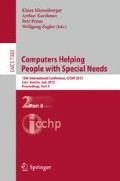Abstract
The need for Assistive Technologies in Europe is leading to the development of projects which aim is to research and develop technical solutions for people with long term motor disabilities. The Assistive Technology Rapid Integration & Construction Set (AsTeRICS) project funded by the 7th Framework Programme of the EU (Grant Agreement 247730) aims to develop a supporting multiple device integrated system to help people with upper limbs impairment. To this end, AsTeRICS is following the User Centred Design methods to gather the user requirements and develop solutions in an iterative way. This paper reports requirements prioritization procedures. These procedures are described in order to illustrate the user requirements transformation into technical requirements for the system development.
Access this chapter
Tax calculation will be finalised at checkout
Purchases are for personal use only
Preview
Unable to display preview. Download preview PDF.
References
Population and Social Conditions: Percentual Distribution of Types of Disability by Sex and Age Group. Luxembourg: Eurostat, October 21 (2010), http://appsso.eurostat.ec.europa.eu/ (cited September 1, 2011)
AsTeRICS, http://www.asterics.eu/
ENOBIO (Internet). Barcelona, ES: Starlab, http://www.starlab.es/products/enobio (cited September 1, 2011)
Lin, Y.P., Chao, Y.P., Lin, C.C., Chen, J.H. (eds.): Webcam mouse using face and eye tracking in various illumination environments. IEEE: Engineering in Medicine and Biology 27th Annual Conference, Shanghai. China, September 27-30 (2005)
IRTrans (Internet). Germany: IRTrans, http://www.irtrans.com/en/main.php (cited September 1, 2011)
OSKA Onscreen Keyboard Application (Internet). Preston, UK: Claro Interfaces, http://www.OSKAworld.com (cited September 1, 2011)
Author information
Authors and Affiliations
Editor information
Editors and Affiliations
Rights and permissions
Copyright information
© 2012 Springer-Verlag Berlin Heidelberg
About this paper
Cite this paper
García-Soler, A. et al. (2012). Addressing Accessibility Challenges of People with Motor Disabilities by Means of AsTeRICS: A Step by Step Definition of Technical Requirements. In: Miesenberger, K., Karshmer, A., Penaz, P., Zagler, W. (eds) Computers Helping People with Special Needs. ICCHP 2012. Lecture Notes in Computer Science, vol 7383. Springer, Berlin, Heidelberg. https://doi.org/10.1007/978-3-642-31534-3_25
Download citation
DOI: https://doi.org/10.1007/978-3-642-31534-3_25
Publisher Name: Springer, Berlin, Heidelberg
Print ISBN: 978-3-642-31533-6
Online ISBN: 978-3-642-31534-3
eBook Packages: Computer ScienceComputer Science (R0)

